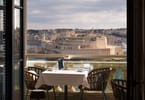Director Cary Fukunaga’s new film, Jane Eyre, was shot betwixt and between the hills and dales of the Peak District of Derbyshire, England, where ancient castles and structures figure into this Victorian masterpiece, penned by Charlotte Brontë. This scenic focus in this film’s rendition is the antithesis of most historical dramas, which rely heavily on script. While this is clearly Charlotte Brontë’s story, these are not her words.
They who know the story will still find the cinematography compelling; the rich visuals gracefully dignify the upcoming 60th birthday of The Peak District National Park, established as the United Kingdom’s first national park on April 17, 1951. Located in the district is the castle where much of the story takes place; Haddon Hall in Derbyshire was “Thornfield Hall” in four other Jane Eyre films, as well as the castle in The Princess Bride, too. This grand estate lends an air of authenticity to Brontë’s opus.
The origins of Haddon Hall date back to the middle ages, when William Peverel de Vernon, my 26th great grandfather, held the manor of Haddon in 1087. A female heiress of the Peverel de Vernon fortune brought title to the castle with her into the Manners family when she married, and the Haddon estate has remained in the family ever since. Author Alfred Gotch, in “The Growth of the English House” (1909) wrote, “The most complete and most interesting house of this period [the fourteenth century] is the well-known Haddon Hall in Derbyshire.” Charlotte Brontë grew up in Thornton, Bradford, West Yorkshire, just 20 miles from The Peak District; she likely knew and loved the area very much.
The character Jane Eyre is probably Charlotte Brontë herself. Brontë worked as a teacher and a governess while young; she lived for a while with two sisters and a brother (like Jane “adopted”). Brontë was born in Thornton, Yorkshire; it is likely therefrom she named the castle where Jane Eyre fell in love, “Thornfield.” Brontë’s mother was dead, her father was absent from the home, and Brontë was raised by an aunt (Elizabeth Branwell), who died while Brontë was in a boarding school. Brontë fell in love with a married man, Constantin Heger, just like Jane, but there’s no evidence that Claire Zoé Parent Heger was crazy, as in the Jane Eyre story. In the tale, the crazy wife conveniently jumps from a castle window to her death, so Jane gets Lord Rochester, but in real life, Madame Heger lived on; Brontë probably wished Madame Heger would defenestrate herself.
Jane Eyre is a beautiful film to watch. It’s like taking a trip to Derbyshire, England without having to leave your home town. Jane Eyre opened nationwide this weekend.
WHAT TO TAKE AWAY FROM THIS ARTICLE:
- A female heiress of the Peverel de Vernon fortune brought title to the castle with her into the Manners family when she married, and the Haddon estate has remained in the family ever since.
- In the tale, the crazy wife conveniently jumps from a castle window to her death, so Jane gets Lord Rochester, but in real life, Madame Heger lived on.
- Brontë fell in love with a married man, Constantin Heger, just like Jane, but there's no evidence that Claire Zoé Parent Heger was crazy, as in the Jane Eyre story.






















